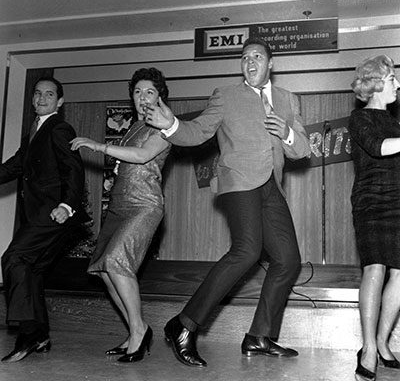
There are moments in American pop culture that don’t just entertain—they define an era. For millions of Americans, one of those moments happened not in a concert hall or a stadium, but on a modest studio floor in Philadelphia. The day a smiling young man named Chubby Checker stepped onto the stage of American Bandstand and introduced a dance called The Twist, something shifted—not just in music, but in youth culture, in family living rooms, and in how America moved.
We didn’t know it at the time, but we were witnessing history.
And more importantly, we were about to feel it in our bones.
The Simplicity That Started a Revolution
What made The Twist so powerful wasn’t complexity. It was the opposite.
You didn’t need a partner. You didn’t need lessons. You didn’t need rhythm perfection.
You just needed your hips, your feet, and a little bit of fun.
For a generation used to ballroom styles or paired routines, The Twist was liberating. It didn’t matter if you were shy, or had two left feet, or had never stepped onto a real dance floor before. As soon as the beat hit, everyone from teenagers to grandmothers could twist the night away—often in socks on a polished kitchen floor.
It started on American Bandstand, but it didn’t stay there for long.
Suddenly, the Twist was everywhere: school dances, family reunions, backyard barbecues, TV variety shows, even the White House.

The First Time We Saw It
If you were watching Bandstand that day, you’ll remember how the crowd leaned in as Chubby Checker stepped onto the stage. He was young, charming, and full of energy. As the music started—“Come on baby, let’s do the Twist…”—you didn’t need instructions. You just started moving.
The audience cheered, but the impact rippled far beyond that studio.
In homes across America, teenagers gasped. Parents rolled their eyes—or secretly tried it when no one was watching. Siblings challenged each other to twist-offs. It was infectious. It was simple. It was ours.
That’s what made The Twist more than a dance.
It became a symbol of youth breaking free from expectations.

The Pony Arrives
After The Twist came another sensation from Chubby Checker: The Pony.
It didn’t have the cultural shock value of The Twist, but it had something even more delightful—pure joy. The Pony was bouncier, lighter, and full of life. You bounced on your feet as if you were riding a horse, swaying your arms and shoulders to the beat. It became a favorite among younger teens and kids, a kind of gateway dance to the bigger steps.
What The Pony did best was remind us that dancing could still be silly—and that silliness had a place on national television.
Bandstand didn’t just present the latest moves—it embraced the playfulness of dancing. It showed kids laughing while doing The Pony, encouraged by Dick Clark’s gentle grin and the ever-present pulse of rock ’n’ roll. It wasn’t about perfection—it was about participation.

More Than Just Music
Both The Twist and The Pony were more than fads—they were markers of cultural change.
Before Bandstand, dancing was formal. You danced with someone. You held a partner. There were rules. But Chubby Checker, with the help of a TV show that trusted young people, changed that forever. Dancing became about individual expression. About taking up space. About feeling music, not just following it.
For teenagers in the late ’50s and early ’60s, that meant everything.
It was a form of freedom at a time when life could feel tightly scripted—by parents, by school, by society.
And for parents watching from the sofa, there was something surprisingly heartwarming about seeing their children so full of joy, confidence, and rhythm. The Twist may have raised a few eyebrows, but it brought families together too—laughing, dancing, and maybe even learning a step or two.
The Legacy Lives On
Even decades later, The Twist hasn’t gone away. It appears in movies. In weddings. At family parties. It’s one of the few dances that people of all ages still recognize—and can do within seconds. It’s intergenerational joy, wrapped in a few easy moves and a beat that never gets old.
As for Chubby Checker, he’s not just a performer. He’s a legend.
His name is forever linked to a movement that made dancing more democratic, more fun, and more meaningful. The Twist wasn’t just a hit—it was a heartbeat. A memory. A national moment.
A Final Spin
Today, as we look back at the golden era of American Bandstand, it’s hard not to smile when we remember how The Twist and The Pony made us feel.
For some, they were a first dance.
For others, a confidence booster.
For many, they were the sound of youth echoing down a hallway, past the vinyl records, past the transistor radio, past the warm living room lights—and into forever.
So if you hear that opening line again—
“Come on baby, let’s do the Twist…”
—don’t just sit there.
Get up. Move. Remember. Smile.
Because the beat may have started back then…
…but it still lives in you.